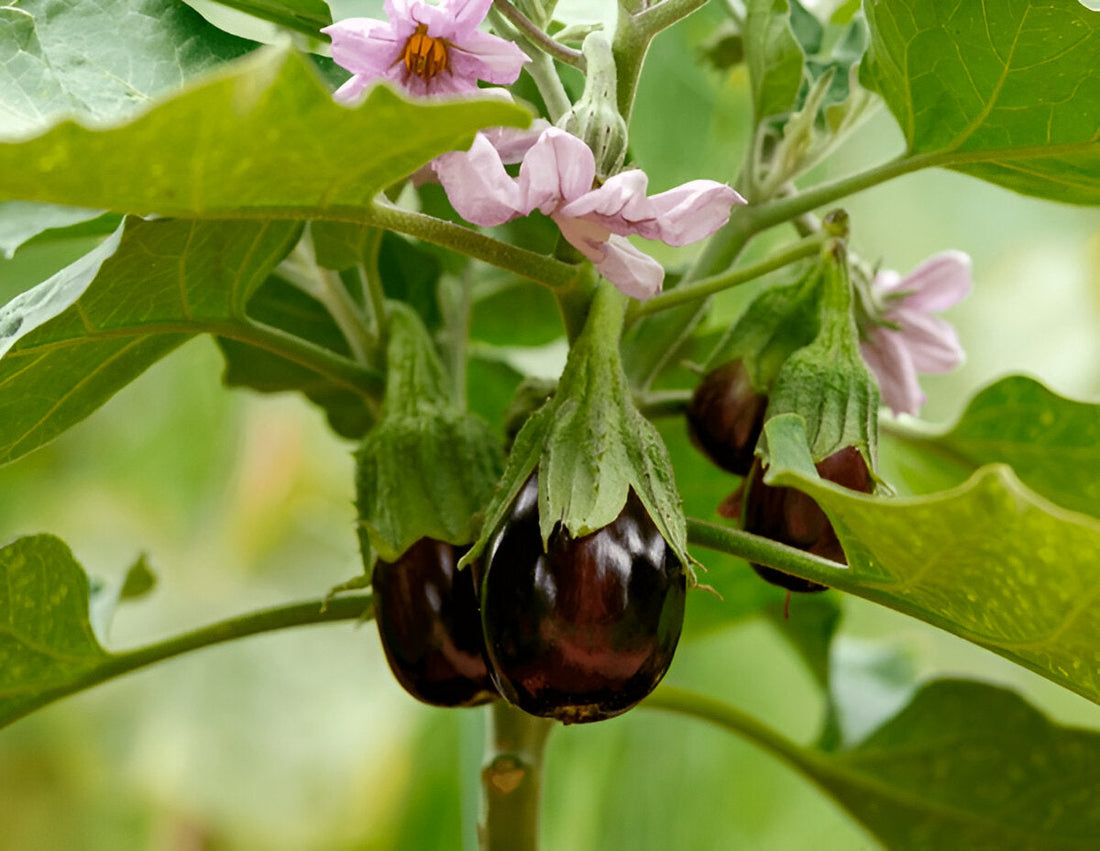
Grow Brinjal in Pakistan: Complete Guide
Share
Growing brinjal (بینگن) at home is simple and highly rewarding. Whether you enjoy it roasted, curried, or fried, fresh baingan straight from your garden tastes richer and is free of chemicals. Here’s an easy guide to growing brinjal successfully in Pakistan’s climate.
| Aspect | Details |
|---|---|
| Best Sowing Time | February to April |
| Ideal Temperature | 22°C to 30°C |
| Germination Time | 7–14 days |
| Transplant Time | 4–5 weeks after sowing |
| Spacing | 18–24 inches between plants |
| Harvest Time | 80–100 days after sowing |
Step 1: Sow Seeds 🌱
When to Sow:
- Sow seeds from February to April in Pakistan, when temperatures are warming but not yet extremely hot.
- The ideal soil temperature for sowing is 22°C to 30°C.
- Avoid sowing during cold weather, as brinjal seeds need warmth to germinate properly.
How to Sow: Start seeds in seed trays or small pots. Sow seeds 0.25 inch deep in a light, well-draining seed-starting mix.
Germination Tips: Seeds usually germinate in 7–14 days. Keep soil moist and warm, and cover trays lightly with plastic if nights are cool.
Step 2: Transplant Seedlings 🌿
When to Transplant: Transplant when seedlings are 4–6 inches tall and have 4–5 true leaves, typically 4–5 weeks after sowing.
How to Transplant: Move into 12–14 inch pots or garden beds, spacing plants 18–24 inches apart for healthy growth.
Aftercare: Water well after transplanting. Choose a sunny spot with good air circulation to avoid fungal diseases.
Step 3: Care for Plants 🌞💧
Sunlight Needs: Provide 6–8 hours of direct sunlight daily for strong flowering and fruiting.
Watering: Water deeply 2–3 times a week, keeping soil evenly moist but not soggy. Reduce watering once fruits start maturing.
Feeding Schedule: Feed with NPK 20-20-20 fertilizer every 15 days after transplanting. Switch to NPK 5-15-45 once plants start flowering to boost fruit quality.
Step 4: Protect Plants 🐛
Common Pests: Watch for aphids, whiteflies, and fruit borers damaging leaves and fruits.
Natural Protection: Spray neem oil solution every 10–12 days (1 teaspoon neem oil + 1 liter water + few drops soap), especially on the undersides of leaves.
Common Problems:
- Dropping Flowers: Often due to stress or irregular watering — keep soil moisture steady.
- Fruit Rot: Caused by excess humidity — improve air circulation and avoid overhead watering.
- Yellow Leaves: Indicate overwatering or poor soil drainage — water only when topsoil feels dry.
Step 5: Harvest Fruits 🍆
When to Harvest: Brinjal is ready 80–100 days after sowing, when fruits are shiny, firm, and about 4–6 inches long, depending on variety.
How to Harvest: Cut fruits with scissors or a knife, leaving a short piece of stem attached for longer shelf life.
Bonus Tip: Regular harvesting encourages the plant to produce more fruits throughout the growing season.
FAQs
Can I grow brinjal in pots?
Yes, brinjal grows very well in 12–14 inch pots with good soil and sunlight.
How tall does a brinjal plant grow?
Plants usually grow 2–4 feet tall, depending on the variety and growing conditions.
Why are my brinjal flowers dropping off?
This happens due to sudden temperature changes or uneven watering. Keeping conditions steady helps retain flowers.
Do brinjal plants need support?
In windy areas or for taller varieties, light staking helps keep the plant upright when loaded with fruits.
Can I grow brinjal in partial shade?
Partial shade is tolerated, but full sun (at least 6 hours daily) gives the best flowering and fruiting results.
Brinjal is a great choice for home gardeners looking for high yields in small spaces. With steady sunlight, deep watering, and light feeding, you'll soon enjoy your own fresh baingan — perfect for your favorite dishes.

